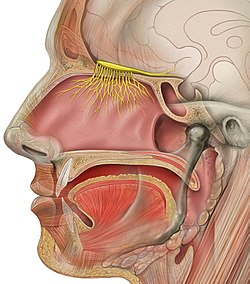Olfactory nerve
| Olfactory nerve | |
|---|---|

Head bisection showing location of olfactory mucosa and cribriform plate. Olfactory nerves are too small to b e seen in a gross section. (Suarez, C.A. and Vilensky, J., All-in-One Anatomy Exam Review. Vol. 1 Back and Upper Limb)
|
|

The Olfactory Nerve
|
|
| Details | |
| Identifiers | |
| Latin | nervus olfactorius |
| MeSH | A08.800.800.120.640 |
| TA |
A14.2.01.004 A14.2.01.005 |
| FMA | 46787 |
|
Anatomical terms of neuroanatomy
[]
|
|
The olfactory nerve is typically considered the first cranial nerve, or simply CN I, that contains sensory nerve fibres relating to smell.
The afferent nerve fibers of the olfactory receptor neurons, transmit nerve impulses about odors to the central nervous system, where they are perceived by the sense of smell (olfaction). Derived from the embryonic nasal placode, the olfactory nerve is somewhat unusual among cranial nerves because it is capable of some regeneration if damaged. The olfactory nerve is sensory in nature and originates on the olfactory mucosa in the upper part of the nasal cavity. From the olfactory mucosa, the nerve (actually many small nerve fascicles) travels up through the cribriform plate of the ethmoid bone to reach the surface of the brain. Here the fascicles enter the olfactory bulb and synapse there; from the bulbs (one on each side) the olfactory information is transmitted into the brain via the olfactory tract. The fascicles of the olfactory nerve are not visible on a cadaver brain because they are severed upon removal.
The specialized olfactory receptor neurons of the olfactory nerve are located in the olfactory mucosa of the upper parts of the nasal cavity. The olfactory nerves consist of a collection of many sensory nerve fibers that extend from the olfactory epithelium to the olfactory bulb, passing through the many openings of the cribriform plate, a sieve-like structure of the ethmoid bone.
...
Wikipedia
